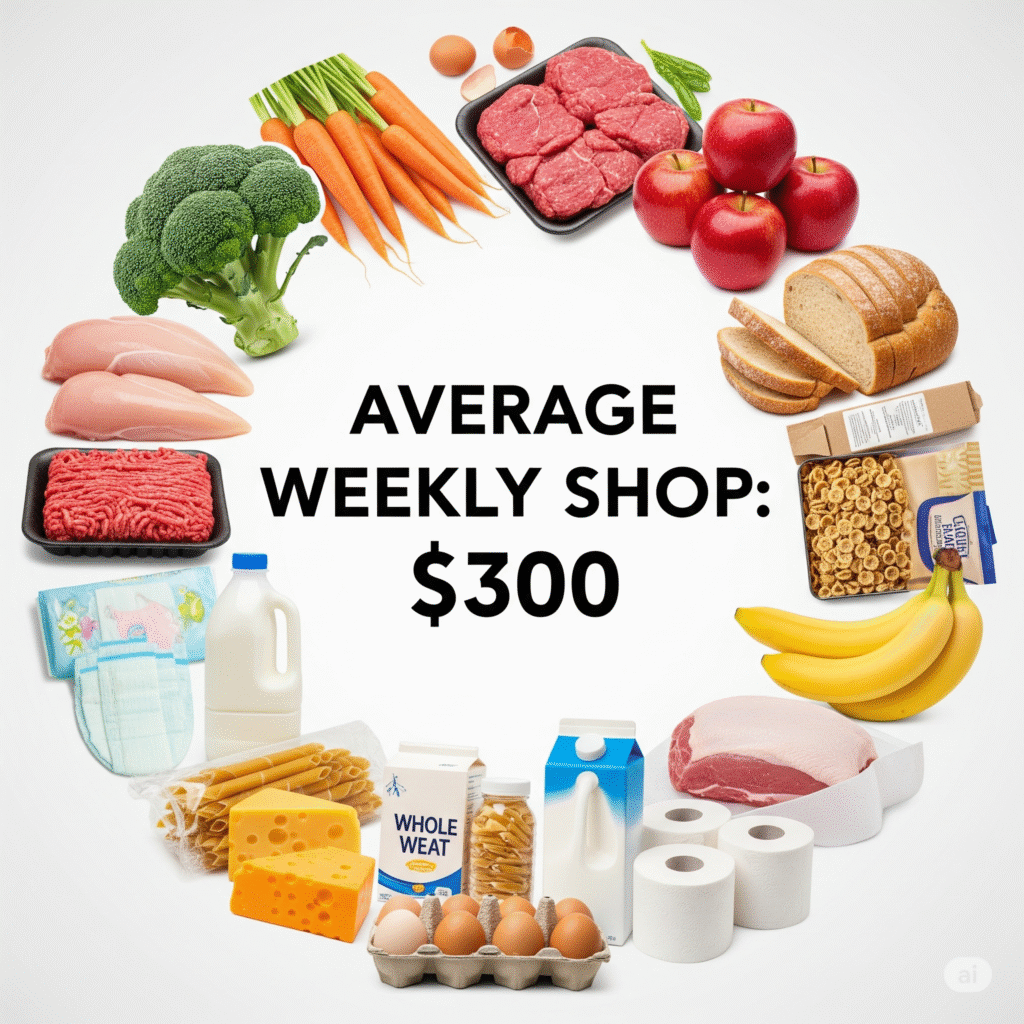Physical Address
304 North Cardinal St.
Dorchester Center, MA 02124
Physical Address
304 North Cardinal St.
Dorchester Center, MA 02124


We all know the cost of living has skyrocketed. There isn’t a single person who hasn’t stood at a checkout, looked at the total on the screen, and thought, “Hang on, I’m sure I’m paying more and getting less.” I know I’ve had more than my fair share of double takes while at the checkout.
At the same time, the news seems to be a tale of two different worlds. In one, we hear constant reports of families struggling to keep up. In the other, we see headlines about record profits for the big companies. Just today (26/8/25), Coles announced another huge profit, noting that people were “spending more”, well, of course we are! Everything is more expensive. I’m sure the shareholders are happy, though.
Then there’s the anecdotal evidence we see every day. I remember when a dozen eggs was maybe $3 or $4. Now, you’d be lucky to find them for less than $6 or $7. That’s nearly a double-up in just a few short years. Inflation is wild, isn’t it? But inflation by itself shouldn’t double prices in a couple of years… Most of it is probably greed, pure corporate greed.
I’m also pretty sure my salary hasn’t seen a 50-60% increase in that same timeframe. Let me check… yup, I was right. At best, it’s been a measly 1-2% increase here and there, and let’s not forget those lovely COVID years when all salary increases were conveniently frozen due to a challenging economic environment. I have a sneaking suspicion the big corps still managed to make a tidy profit back then, too.
Anyway, I could whinge all day about the cost of living, but I think everyone gets the picture. Everything is more expensive, yet most of us are not making more money. It sucks.
But rather than just complaining, let’s see what we can actively do about it. In this post, we’re going to explore what is arguably the biggest and most volatile part of any family’s budget. The cost of food and groceries.
Let’s do some quick maths. Imagine a typical family of four, like ours—two adults and two young kids. Based on current averages here in Australia, a regular weekly grocery shop at Coles or Woolworths can easily cost around $300.
Now, you might be thinking, “$300? How does it add up so quickly?” It’s a fair question. Let’s break down what a sample weekly basket might look like to hit that number.
Here’s a rough sketch of a family’s grocery list. This isn’t an extravagant shop, it’s the everyday reality of keeping a family fed and a household running.
1. Fresh Produce (approx. $65)
2. Meat & Poultry (approx. $70)
3. Pantry Staples (approx. $60)
4. Dairy & Chilled (approx. $45)
5. Drinks & Miscellaneous (approx. $25)
6. Non-Food & Household Items (approx. $35)
Grand Total: ~$300

As you can see, it’s not lavish spending. It’s the standard, relentless drip-drip-drip of everyday essentials that quickly adds up.
Now, let’s see what that looks like over a full year:
Fifteen. Thousand. Dollars. Just on groceries. For a family on average Australian salaries, that is a huge chunk of your income, especially after tax and nothing to be sneezed at. And that’s before you even get to the really expensive kid-specific stuff. If you need more nappies, formula, or an endless supply of toddler-approved snacks, that number climbs even higher. Kids are expensive, I tell you!
From our personal experience, while our costs aren’t drastically lower, we do tend to come in under that $300 weekly average. Some weeks we might spend more, but that’s usually when we’re strategically buying in bulk because something is on special, or perhaps we’ve gone and treated ourselves to something special.
We don’t necessarily skimp on quality, and we do our best to maintain a balanced diet. Our main strategy is simple: we keep an eye on specials and we shop around.
Yes, this takes a bit more time and planning. You can’t always do your entire shop in one place, and you might need to get creative with your meal prep based on what’s on sale. Prawns are half-price this week? Guess we’re having prawns! To do this, we use a mix of stores like Costco for bulk items, Aldi for their great prices, and fresh food markets for some produce, depending on what we need.
We typically do our weekly shop with the kids on a weekend, which can take an hour or two, and we treat it like an adventure. We get them involved in picking out fruits and vegetables, which helps them feel part of the process and (sometimes) makes them more likely to eat it! It doesn’t need to feel like a chore. Life isn’t always about the big expensive holiday or activity, sometimes it is the small things which can bring joy and fun. It is all a matter of perspective. Your life will be as fun as you want it to be!

Of course, we understand that time equals money. Services like Amazon or other grocery delivery services offer incredible convenience, but you are paying a premium for that time-saving. If that works for you and your family, that’s fantastic. For us, we don’t mind spending a bit more time to manage our costs. And because we try to involve the kids in this as well, it means just that little bit of extra time with the kids too.
So, what are the best ways to get started? Here are some of our go-to hints and tips that could help you save a significant amount of money over the long run.

1. Look Beyond the Duopoly Our supermarket duopoly of Coles and Woolworths dominates the Australian landscape, and it shows in their pricing. They know most people want the convenience of a one-stop-shop, so they might price a few items cheaply to entice you in (milk, bread or a few other staples that most people want), but they’ll charge you more on everything else to balance it all out. While their stores seem to be on every corner, alternatives are often closer than you think, especially in city areas. For those in regional towns, it can be more challenging, but it’s worth checking for an IGA or a local market. Google Maps is your friend, a quick search for “Aldi,” “Costco,” or “fruit and veg market” might reveal some convenient, money-saving options. Or try asking around, I’m sure most people will have a place they tend to visit because the prices are more competitive.
2. Embrace Aldi and Costco These two stores offer amazing value through different strategies. Aldi uses high-quality private labels that are often a fraction of the price of branded equivalents. Costco sells in bulk, which means a lower price per unit. While Costco has a membership fee, the savings can easily cover the cost if you have a family and storage space.
Let’s look at a quick price comparison on some staples (note: prices are approximate and can change):
| Product (per 100g/mL) | Coles/Woolies (Brand) | Aldi (Private Label) | % Savings (vs Brand) |
| Corn Flakes | ~$1.00 (Kellogg’s) | ~$0.45 (Hillcrest) | ~55% |
| Tasty Cheese Block | ~$2.00 (Bega) | ~$1.30 (Westacre) | ~35% |
| Greek-style Yogurt | ~$0.70 (Chobani) | ~$0.45 (Lyttos) | ~35% |
Based on the above, you can already see some serious savings could be had from the Aldi prices, and this is just comparing some of the regular staples. If you included other more expensive items, like meat and other fresh produce, the savings add up very very quickly.
Beyond Aldi and Costco, there are also independent stores, or specialty stores where you might also be able to get a good deal. So explore around, you never know what you might find.
3. Master the Weekly Specials Both Coles and Woolworths run deep discount cycles on a weekly basis. When a pantry staple or a favourite snack is on special, buy a bit more and stock up. This isn’t just for essentials, even comfort foods see huge markdowns. Things like potato chips and chocolate are regularly on a 50% discount depending on the brand. Keep an eye on the catalogues, and you’ll be sure to find your favourite treats for half the price.
We use to get the catalogues shoved into our mailbox weekly, so we often do a quick scan of those to plan ahead prior to our weekend grocery shop. But these days, the catalogues are uploaded on the supermarkets respective websites, so it is even more convenient. At most it takes a few minutes to have a quick look and jot down things you may want to buy.
4. Shop Seasonally Fruit and vegetables that are out of season are either imported or have been in cold storage for a long time, making them far more expensive, and potentially impacts the taste too. Building your meals around what’s fresh and abundant can lead to huge savings.
5. Give Private Labels a Go In recent years, the quality of “store brand”, otherwise known as private label, products has soared. There’s no harm in trying them out, if you don’t like it, you don’t have to buy it again, but you might just find a new staple for a much lower price.
| Product | Named Brand (approx. $) | Private Label (approx. $) | % Savings |
| Milk (2L) | $4.50 (Pura) | $2.60 (Coles/Woolies) | ~42% |
| White Bread | $4.40 (Tip Top) | $2.40 (Coles/Woolies) | ~45% |
| Olive Oil (1L) | $20.00 (Cobram Estate) | $12.00 (Coles/Woolies) | ~40% |
Now we won’t go into the commercials behind private labels, because these are not necessarily the best options for manufacturers who tend to get their margins squeezed due to the growing private labels. But supermarket private labels have grown to be big business, because they are cheap and generally still offer a reasonable quality produce. In more recent times, the supermarkets have also started pushing into the higher quality end, with “Coles Finest” and “Woolworths Gold”. They know exactly what they are doing, private labels can be very lucrative if done right.
6. Manage Your Kids’ Expectations (and Palates) Kids will often demand their favourite food, but this can be a great teaching moment. Our kids adored strawberries, and when they were in season, we could buy them in bulk for a few dollars. But once the season ended, they were hard to find and expensive. So, we explained the situation and switched them over to delicious, sweet, in-season oranges. There were a few scrunched-up faces at first, but after tasting how good they were, the kids were hooked. This not only manages the budget but also encourages them to be less fussy and appreciate what’s fresh.
The kids may not appreciate this for the moment, but when they grow up and retain those healthy eating habits, I’m sure they will thank you for it. There is so much ultra processed foods that is easily available now, the more fresh and healthy food we can shovel into them now, the better!
These are just a handful of the strategies that have worked for our family, but I know there are countless other brilliant ideas out there. We’re all in this together, trying to navigate the supermarket squeeze and the rising cost of living.
So, what are your go-to tips for cutting down the grocery bill? Have you found a hidden gem of a store, or do you have a killer budget recipe to share?
Please drop your best ideas and savings hacks in the comments below. Let’s help each other out!